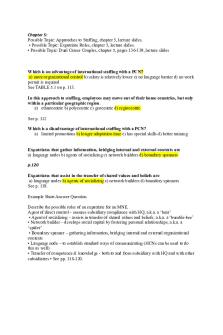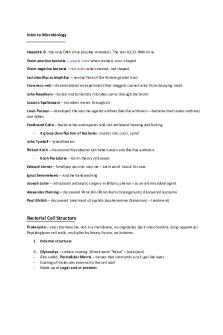Example Answers to Gram Stain Questions PDF

| Title | Example Answers to Gram Stain Questions |
|---|---|
| Course | Microbiology |
| Institution | Portland Community College |
| Pages | 2 |
| File Size | 39.5 KB |
| File Type | |
| Total Downloads | 94 |
| Total Views | 134 |
Summary
lab micro 234 example homework questions and answers...
Description
Gram Stain Questions 1.
What is a complex stain? A complex stain is a staining technique that uses multiple reagents in the protocol. (A simple stain uses only a single reagent.)
2.
What is a differential stain? A differential stain is able to detect differences in bacterial cell structure(s).
3.
Is the Gram stain a complex or simple stain? The Gram stain is a complex stain.
4.
5.
In the Gram stain, what reagent is used as the: a.
Primary stain – Crystal violet
b.
Mordant – Gram’s iodine
c.
Decolorizer – 95% ethanol/acetone
d.
Counterstain - Safranin
How long is a smear heat-fixed prior to performing a Gram stain? Bacterial smears are heat-fixed for 20 seconds before performing a Gram stain.
6.
Does crystal violet bind to peptidoglycan? How is crystal violet retained by Gram-positive cells? Crystal violet does not bind to peptidoglycan. Two steps in the Gram stain serve to ‘trap’ crystal violet within the peptidoglycan. First, the mordant forms a complex with the crystal violet, changing its size, making it less likely to escape the cell wall. Second, proper use of decolorizer dehydrates the peptidoglycan, causing the cell wall to shrink, further trapping the crystal violet.
7.
What step in the Gram stain procedure is most critical? Decolorizing with the acetone/ethanol solution is the most critical step of the Gram stain. It is this step that allows the staining procedure to differentiate between Gram-positive and Gram-negative bacteria.
8.
You perform the Gram stain on a known Gram-positive bacterium. You observe pink bacilli on your slide. What is the most likely explanation for this observation? The most likely explanation for a known Gram-positive bacterium to be pink after the Gram stain is that the bacterial smear was over-decolorized.
9.
You perform the Gram stain on a known Gram-negative bacterium. You observe purple bacilli on your slide. What is the most likely explanation for this observation? When a known Gram-negative bacterium is purple at the end of the Gram stain, it indicates that the bacterial smear was undercolorized.
10. What two cell characteristics can be determined by using the Gram stain? Cell shape and cell wall structure can be determined from a Gram stain. Gram Stain Results Questions 11. What are your observations and conclusions for this correctly performed Gram stain? Observation pink cells longer than they are wide Conclusion Gram-negative bacilli 12. What are your observations and conclusions for this correctly performed Gram stain? Observation purple cells, spherical (clusters of cells are evident) Conclusion Gram-positive cocci (staphylococci) 13. What are your observations and conclusions for this correctly performed Gram stain? Observations (this slide is a mixture of bacteria) purple cells longer than they are wide purple cells, spherical pink cells longer than they are wide Conclusions Gram-positive bacilli Gram-positive cocci Gram-negative bacilli...
Similar Free PDFs

Gram Stain Lab - to help study
- 2 Pages

Complete Gram Stain Lab
- 4 Pages

BIO 2205 Gram Stain Lab Report
- 9 Pages

Lab3 answers to questions
- 3 Pages

Answers to the questions
- 27 Pages
Popular Institutions
- Tinajero National High School - Annex
- Politeknik Caltex Riau
- Yokohama City University
- SGT University
- University of Al-Qadisiyah
- Divine Word College of Vigan
- Techniek College Rotterdam
- Universidade de Santiago
- Universiti Teknologi MARA Cawangan Johor Kampus Pasir Gudang
- Poltekkes Kemenkes Yogyakarta
- Baguio City National High School
- Colegio san marcos
- preparatoria uno
- Centro de Bachillerato Tecnológico Industrial y de Servicios No. 107
- Dalian Maritime University
- Quang Trung Secondary School
- Colegio Tecnológico en Informática
- Corporación Regional de Educación Superior
- Grupo CEDVA
- Dar Al Uloom University
- Centro de Estudios Preuniversitarios de la Universidad Nacional de Ingeniería
- 上智大学
- Aakash International School, Nuna Majara
- San Felipe Neri Catholic School
- Kang Chiao International School - New Taipei City
- Misamis Occidental National High School
- Institución Educativa Escuela Normal Juan Ladrilleros
- Kolehiyo ng Pantukan
- Batanes State College
- Instituto Continental
- Sekolah Menengah Kejuruan Kesehatan Kaltara (Tarakan)
- Colegio de La Inmaculada Concepcion - Cebu










